Dramatic Vocalise Database
"(Un)Heavenly Choruses," Spaghetti Westerns, and Morricone's Dollars Trilogy
Music and the Moving Image VI
NYU Steinhardt School of Culture, Education, and Human Development (May 2011)
(This paper needs copious footnotes . . . )
With the addition of sound to cinema in the late 1920s, associations between visual modes of expression and corresponding musical representation found in nineteenth-century opera were transferred from the stage to the screen. This included non-diegetic dramatic vocalization, better known within film-composer circles as the "Heavenly Chorus." The use of dramatic vocalization within a cinematic narrative was first used to express lamentation or the supernatural, e.g. White Zombie (1932), Lost Horizon (1937), or The Wizard of Oz (1939). As the following decades progressed, film composers expanded the use of this device to signify religious or numinous connotations, eventually leading to its inclusion in Hollywood Biblical epics, most notably in the scores of Miklós Rózsa.
In this paper I propose that composer Ennio Morricone was exposed to and influenced by the film music of Biblical epics, most notably the use of a "Heavenly Chorus," transferring the device, and also transforming it in the process, to a new genre, the Spaghetti Western—and in the case of this paper, specifically what has been termed the Dollars Trilogy. Instead of using traditional folk-tunes and a neo-Romantic orchestra, as found in previous Hollywood Western film scores, Morricone took a different path, one that established a new set of clichés that would endure for over the next fifty-plus years.
The "Heavenly Chorus" is a well-worn musical cliché that has been used in contexts ranging from cinematic epics to television commercials, for such things as the birth of the Messiah to the singing of praise for a new brand of laundry detergent—a bright light shines down accompanied by the wordless vocalization of invisible seraphim, highlighting the supposed supernatural aspects of the product or mise-en-scène. Morricone's only use of the "Heavenly Chorus" in this traditional sense within the Dollars Trilogy comes from an early scene in The Good, the Bad and the Ugly as Lee Van Cleef observes Clint Eastwood about to shoot down Eli Wallach from a noose.
| The Good, the Bad and the Ugly (1966): "Heavenly Angel" [0:26:12] "Even a filthy beggar has got a protecting angel. A golden-haired angel watches over him." |
After graduating from Rome's Conservatory of Santa Cecilia with degrees in composition, orchestration, conducting, and trumpet, Morricone settled in at RAI, the Italian national radio network, as a successful arranger. It would be several years before he expressed any interest in film music; Alfred Newman's epic 1953 score for The Robe [with significant amounts of "Heavenly Chorus"] apparently spurred his consideration of the medium's potential. Thus inspired, Moricone worked as an orchestrator for composer Mario Nascimbene on Death of a Friend [Morte di un amico] (1959) and director Richard Fleischer's Biblical epic Barabbas (1961) [which also includes moments of "Heavenly Chorus"].
During this period the number of Hollywood Westerns being produced began to decline due to competition from popular television shows such as Rawhide [including Clint Eastwood as a cast member] and Gunsmoke, yet the European appetite for the genre remained. With the success of the German Winnetou movies (from 1962 onward) a new trend followed. Highly skilled film crews, sitting idle after Hollywood production units pulled out of Spain, a landscape somewhat similar to the American southwest, and low production costs would soon lead to joint Spanish/Italian endeavors, and the birth of the Spaghetti Western.
For A Fist Full of Dollars director Sergio Leone originally wanted to use composer Francesco Lavagnino, who had scored the director's two previous films, the sword-and-sandal pseudo-epics The Last Days of Pompeii (1959) and The Colossus of Rhodes (1961), but Leone's distributor, Jolly Films, suggested Morricone. It was not an altogether untoward recommendation: Morricone had previously scored Gunfight at Red Sands (1963) and was just then completing the score for another early Italian Western, Pistols Don't Argue (1964). Leone was not impressed by the music for Gunfight at Red Sands since it sounded too much in the same vein as Dimitri Tiomkin's scores for American Westerns, yet, when pressed, Morricone's response was that that is what he had been paid to write at the time.
Leone instead was interested in an arrangement Morricone had made of Woodie Guthrie's song "Pastures of Plenty" for the American tenor Peter Tevis released as a single in Italy by RCA in 1962. The arrangement included a strong vocal line accompanied by whip-cracks, tubular bells, and a brief scale of sixteenths on soprano recorder. Of note is an insistent rhythm (eigth-sixteenth-sixteenth) often associated with galloping horses found throughout all three films of the Dollars Trilogy, as well as other tunes associated with the American West, including the theme from Bonanza, Rossini's William Tell Overture/The Lone Ranger theme, and many others. The accompanying wordless male chorus for "Pastures of Plenty" is identical to that used in the Fistful of Dollars theme.
| Woody Guthrie, "Pastures of Plenty" Sung by Peter Tevis Arranged by Ennio Morricone | |
| Opening Credits for A Fistful of Dollars (1964) Ennio Morricone is listed in the opening credits under the pseudonym "Dan Savio" |
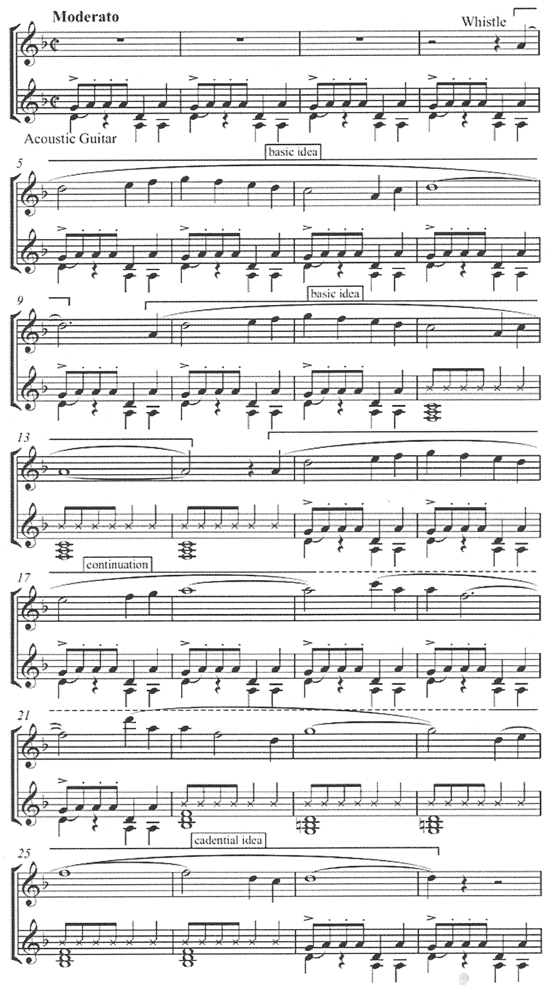
Title Theme, A Fistfull of Dollars, mm. 1–28 (0:00:01–0:00:31) [Kausalik 2008, 27]
The chorus used in A Fistful of Dollars—as well as For a Few Dollars More and The Good, the Bad and the Ugly—was I Cantori Moderni, a group led by Alessandro Alessandroni, who also happens to be the performer behind the crisp, clear whistling as well as the clean, low-reverb Fender Stratocaster guitar solo (a la Duane Eddy or Dick Dale). Alessandroni's choir is used expressly for its timbre, which is clearly heard due to the complete lack of text. What makes Morricone's use of the chorus so unique in the Fistful of Dollars theme is its treatment; rather than using the chorus as an accompaniment to a solo melody, the chorus itself acts as an instrument that emphasizes rhythmic units and harmonic progressions. This striking instrumentation would become one of the most important features of the film, and would be used by Leone over the course of its narrative to play a role in the dramatic process.
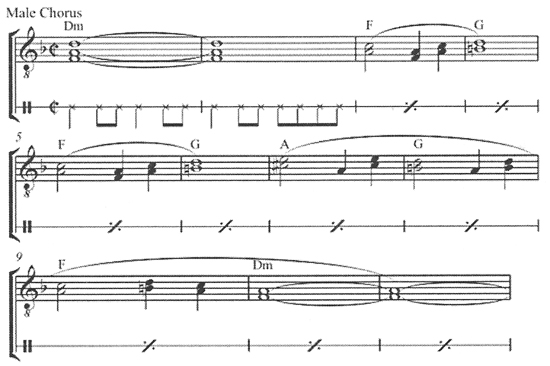
Male Chorus, Title, A Fistfull of Dollars (0:01:37) [Kausalik 2008, 35]
Morricone wrote title music very similar to A Fistful of Dollars for For a Few Dollars More—both are in a modified D dorian and include solo whistling, solo electric guitar, and wordless male chorus. Instead of beginning with an acoustic guitar Morricone uses a Jew's harp to establish the tempo and rhythm. Note that both melodies begin with a prominent ascending 4th from the 5th scale degree to the tonic, and have similar melodic contours—Fistful goes up, For a Few goes down. The latter film also includes a bridge section featuring wordless chorus similar to that in the earlier movie.
| Opening Credits for For a Few Dollars More (1965) |
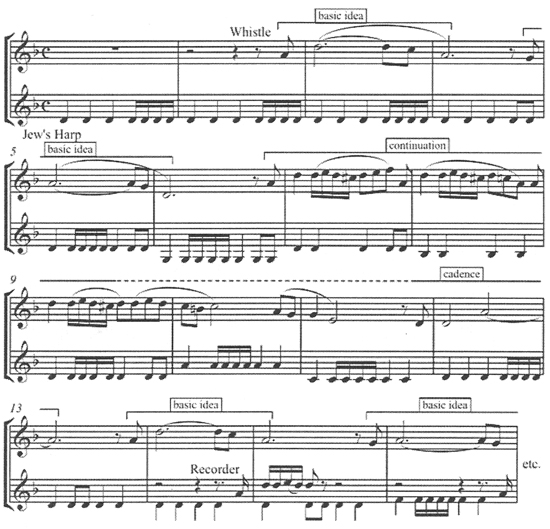
Title Theme, For a Few Dollars More, mm. 1–16 (0:01:09–0:01:43) [Kausalik 2008, 38]

Male Chorus, Title, For a Few Dollars More (0:02:42) [Kausalik 2008, 42]
The Main Title for The Good, the Bad and the Ugly, as well as several other cues in the Dollars Trilogy, are distinguished by gruff vocal chants whose precise language has eluded more than one listener. In a 1994 Score magazine interview with Charles Bernstein Morricone stated, "They weren't saying anything. It was like they were cursing. . . . I didn't care whether the words were understood or not." The title music begins with drumming followed by a repeated ascending 4th motive [the sung version said to be the sound of a coyote], furthering the connection with the previous two films. As before, Morricone again includes a bridge section with wordless chorus.
| Opening Credits for The Good, the Bad and the Ugly (1966) |
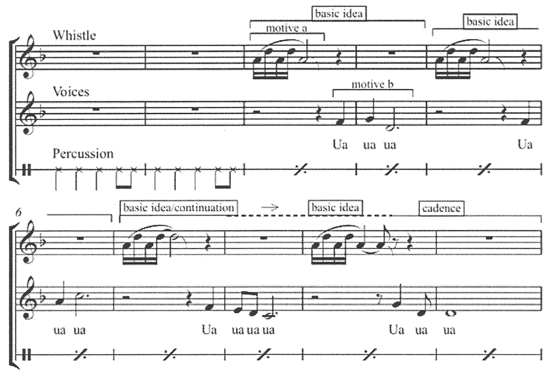
Title Theme, The Good, the Bad and the Ugly, mm. 1–10 (0:00:07–0:00:29) [Kausalik 2008, 48]
For the showdown in A Fistful of Dollars, Leone insisted upon Dimitri Tiomkin's "DeGuello," a theme associated with the Mexican army in The Alamo (1960), but originally composed for Howard Hawks's Rio Bravo (1959), but, to quote from a 1989 interview with Giovanna Grassi in the Hollywood Reporter, Morricone stated, "I would rather kill myself than use someone else's music. Years ago I scored the music for the sea plays written by Eugene O'Neill. There was a lullaby that was sung in a very deep voice popular when O'Neill was alive. I had Leone listen to it and then rewrote it with a Mexican flavor and beat, and we put it in the film. Note the Mariachi-style trumpet with heavy vibrato and the underlying wordless chorus as the dramatic tension builds.
| A Fistful of Dollars—Final Showdown "Theme from A Fistful of Dollars" |
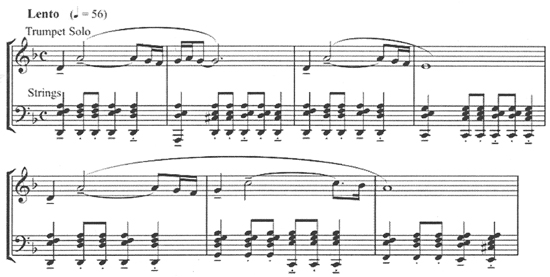
"Theme from A Fistful of Dollars" (0:12:47) [Kausalik 2008, 61]
For the showdown in For a Few Dollars More, Morricone once again used similar music—acoustic guitar, castanets, Mariachi-style trumpet, wordless chorus, a musical watch that features prominently within the narrative, and a melody with a prominent descending 5th, opposite in direction from that in the previous film.
| For a Few Dollars More—Final Showdown "The Musical Pocket Watch"/"Sixty Seconds To What?" |
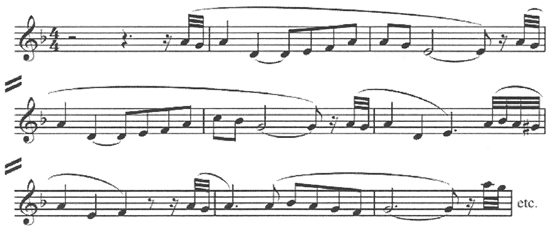
“La Resa Dei Conti” (The Big Gundown), For a Few Dollars More (0:27:25) [Kausalik 2008, 70]
The Good, the Bad and the Ugly has a showdown scene similar to the one in For a Few Dollars More since both involve three protagonists and are set in an arena. Once again there are chimes similar to the musical watch in the previous film, the Mariachi-style trumpet, now with a melodic contour that emphasizes the tonic and 5th scale degrees instead of an opening leap, and wordless chorus. In this scene, unlike the two previous films, the dramatic tension is increased through a change of meter, quickening the pace and urgency of the final situational resolution.
| The Good, the Bad and the Ugly—Final Showdown |
Unlike the American Westerns of Sam Peckinpah and others where the main feature is the shootout, Leone's films instead focus on the showdown. Beginning with a distant camera shot, each showdown progressively builds, with the viewer presented with closer and closer views of the characters, eventually focusing on their eyes and their guns. It is during these moments of ever increasing tension where the sound, the music, is elevated to a position comparable to the image in function and presence, if not more so. The music, the framing, the camera movement, the bigger-than-myth epic characters, and story are, to quote director Martin Scorsese, "opera."
In conclusion, and to explain this paper's title, through his collaborative work with Alessandro Alessandroni's I Cantori Moderni and their ensuing relationship that would define all of Morricone's Spaghetti Western film scores throughout the 1960s, a differing approach from the previous Hollywood style emerged. It is because of this overwhelming and long-term influence that I refer to these three movies as Morricone's—and not Leone's—Dollars Trilogy.
Although he would utilize the "Heavenly Chorus" in Once Upon a Time in the West to underscore the angelic nature of the character played by Claudia Cardinale (via the soaring soprano voice of Edda Dell'Orso) it simply does not occur in the Dollars Trilogy other than the one singular instance from The Good, the Bad and the Ugly. There simply isn't a sympathetic female character, nor anything else deserving of an angelic choir. Instead of signifying—to accompany or associate wordless vocalization with some sort of supernatural or numinous extra-musical idea—Morricone used wordless vocalization in an instrumental fashion to heighten the dramatic tension within the mise-en-scène in a truly unique fashion, thus being "unheavenly."